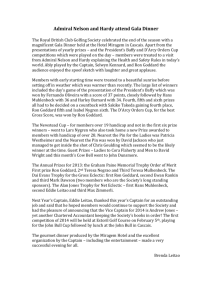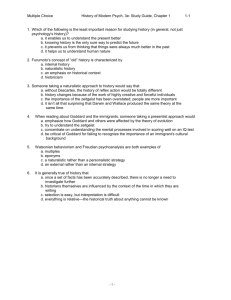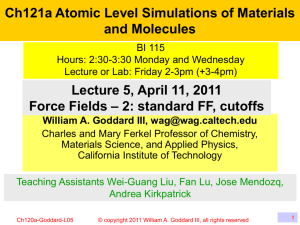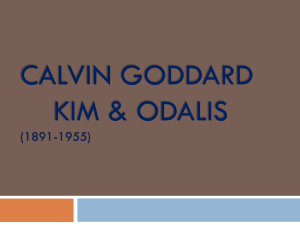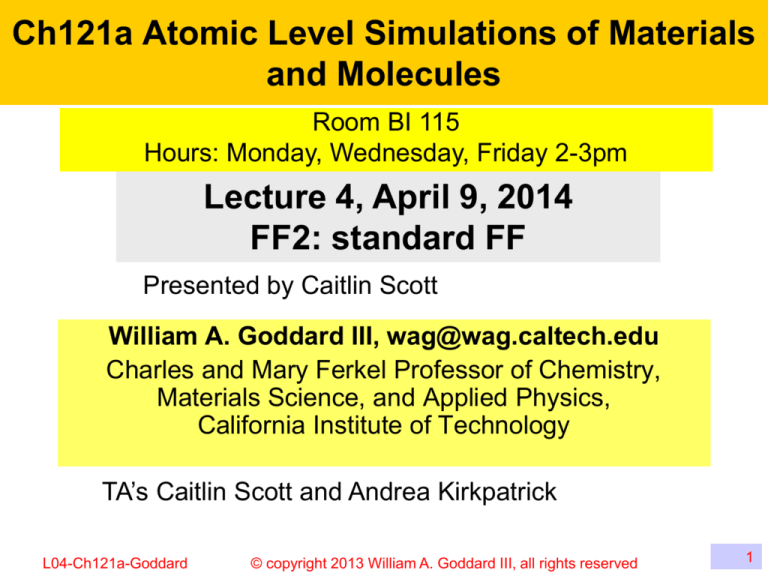
Ch121a Atomic Level Simulations of Materials
and Molecules
Room BI 115
Hours: Monday, Wednesday, Friday 2-3pm
Lecture 4, April 9, 2014
FF2: standard FF
Presented by Caitlin Scott
William A. Goddard III, wag@wag.caltech.edu
Charles and Mary Ferkel Professor of Chemistry,
Materials Science, and Applied Physics,
California Institute of Technology
TA’s Caitlin Scott and Andrea Kirkpatrick
L04-Ch121a-Goddard
© copyright 2013 William A. Goddard III, all rights reserved
1
Homework and Research Project
First 5 weeks: The homework each week uses generally available
computer software implementing the basic methods on
applications aimed at exposing the students to understanding how
to use atomistic simulations to solve problems.
Each calculation requires making decisions on the specific
approaches and parameters relevant and how to analyze the
results.
Midterm: each student submits proposal for a project using the
methods of Ch121a to solve a research problem that can be
completed in the final 5 weeks.
The homework for the last 5 weeks is to turn in a one page report
on progress with the project
The final is a research report describing the calculations and
conclusions
L04-Ch121a-Goddard
© copyright 2013 William A. Goddard III, all rights reserved
2
Dreiding
Dreiding is a generic or rule-based force field.
Parameters were based on general principles, not fitted to specific
molecules
Bond distance = RA + RB -0.01A where RA are bond radii based
on the A-CH3 bond distance.
Bond angles based on hydride: HOH=104.5°, HSH=92.2°,
H--C_3--H = 109.5°, H--C_2--H = 120°, H--C_1--H = 180°,
Steve Mayo, Barry Olafson, WAG, “DREIDING - A Generic Force-field for
Molecular Simulations,” J Phys Chem 94 8897 (1990)
L04-Ch121a-Goddard
© copyright 2013 William A. Goddard III, all rights reserved
3
Dreiding
Dreiding is a generic or rule-based force field.
Parameters were based on general principles, not fitted to specific
molecules
Bond distance = RA + RB -0.01A where RA are bond radii based on
the A-CH3 bond distance.
Bond angles based on hydride: HOH=104.5°, HSH=92.2°,
H--C_3--H = 109.5°, H--C_2--H = 120°, H--C_1--H = 180°,
Force constants”
Kbond = BO*700 kcal/mol/Å2 where BO bond order (1,2,3)
Kangle = 100 kcal/mol/rad2.
Inversion barrier for planar molecules = 40 kcal/mol/rad2
torsion barrier = 2.0 kcal/mol for single bonds
45 kcal/mol for double bonds
Steve Mayo, Barry Olafson, WAG, “DREIDING - A Generic Force-field for
Molecular Simulations,” J Phys Chem 94 8897 (1990)
L04-Ch121a-Goddard
© copyright 2013 William A. Goddard III, all rights reserved
4
Dreiding Atom Types
C_1, C_2, C_3 indicate sp,sp2, and sp3 hybridized carbon atoms
That is C_3 is a tetrahedral C with 4 bonds
C_2 is a trigonal C with 3 bonded atoms (one is a double bond)
C_1 has two bonds, one of which is a triple bond
C_R is sp2 but in an aromatic ring
These may have different FF parameters but vdw and Q depend
only on the element
• Atom Type rules make possible the correct assignment of
force field parameters throughout the molecule
• The rules are easy for “chemists” to understand and easy to
code
• Also they allow automatic autotyping
L04-Ch121a-Goddard
© copyright 2013 William A. Goddard III, all rights reserved
5
Example
Atom Types
tetrapeptide
Lys-Met-Phe-Pro
L04-Ch121a-Goddard
© copyright 2013 William A. Goddard III, all rights reserved
6
Geometric Valence parameters for Dreiding
L04-Ch121a-Goddard
© copyright 2013 William A. Goddard III, all rights reserved
7
The van der Waals Parameters for Dreiding
R0 is total bond
distance, vdw radius
is ½ this size
R0=3.195 for H
was a bad choice.
Should have been
2.6-2.7. it is
compensated by a
small D0
Parameters in
the same row
are similar.
General trend
to larger Re
and De as go
down the
columns
L04-Ch121a-Goddard
© copyright 2013 William A. Goddard III, all rights reserved
8
Dreiding parameters for dihedrals
E(φ) = ½ B[1+(-1)CM cos(Pφ)]
a Two sp3 atoms: B=2, P=3, 0° is max
B=barrier (kcal/mol)
b One sp3-one sp2: B=1, P=6, 0° is min
P = periodicity
CM=+1 if 0° is min
c two sp2 (BO=2): B=45, P=2, 0° is min
= 0 if 0° is max
d two sp2R (BO=1.5): B=25, P=2, 0° is min
e two sp2 (BO=1): B=5, P=2, 0° is min
f two sp2R (BO=1.0): B=10, P=2, 0° is min
g one or two sp1, monovalent (F..), metals (Fe..) all have B=0
h sp3-sp3 in O column: B=2, P=2, 0° is max
i sp3 O column-sp3 other column: B=2 P=2, 0° is min
j exception to b: if sp2 is bonded to one H: then B=2, P=3, 0° to H
is max (eg propene)
k barriers should decrease by factor of 3 as go down column, but
this trend was ignored in Dreiding
L04-Ch121a-Goddard
© copyright 2013 William A. Goddard III, all rights reserved
9
Validation: experimental
barriers (kcal/mol)
L04-Ch121a-Goddard
© copyright 2013 William A. Goddard III, all rights reserved
10
Compare conformations to experiment
L04-Ch121a-Goddard
© copyright 2013 William A. Goddard III, all rights reserved
11
Dreiding validate using 1st 76 molecules in
Cambridge Crystallographic Data Base (in 1988)
L04-Ch121a-Goddard
© copyright 2013 William A. Goddard III, all rights reserved
12
Dreiding accuracy over 76 molecules
Note that the test minimized the molecule in a vacuum.
The
experiment was in
a crystal
L04-Ch121a-Goddard
© copyright
2013 William A. Goddard III, all rights reserved
13
Complex case Linear CF3-(CF2)n-CF3
C6F14 Dihedral QM energy (B3LYP, 631G*)
Get F—F
steric
interactions
for F on C1
and C3
3.5
3
Energy (Kcal/mol)
2.5
2
1.5
150º
L
K
164º
1
0.5
0
145
150
155
160
165
170
175
180
185
-0.5
Dihedral angle
180º
Not all trans as for CH3-(CH2)n-CH3
Get 163º torsion not 180º
L04-Ch121a-Goddard
© copyright 2013 William A. Goddard III, all rights reserved
14
Energy Components
Molecular origin of helicity in Teflon
3
torsion
2.5
vdw
Energy (Kcal/mol)
2
electrostatic
Force Field
1.5
FF
electrostatic
QM B3LYP
1
O
0.5
QM
0
150
155
160
165
170
175
180
-0.5
-1
L04-Ch121a-Goddard
f (degrees)
vdW
© copyright 2013 William A. Goddard III, all rights reserved
15
High Pressure forms of C20F42
The figure shows predicted stable helical conformations for C20F42. From left to right t+, t-, g+, g-, h+, and
h- enantiomeric pair conformations. The atoms are colored to facilitate the viewing of their helical nature.
The tighter the dihedral angle (from 164 to 60) the shorter the molecule gets. Fluorine atoms of each color
would be located on the same side if the molecule were prepared in the all-trans conformation.
L04-Ch121a-Goddard
© copyright 2013 William A. Goddard III, all rights reserved
16
DREIDING
E EInternal EVDW EHB ECoulomb
DREIDING
– Internal Energies
• Bond, Angle, Torsion, Inversion
c0 q1q2
– Electrostatics
E
Coulomb
• Point charges
r12
• Dielectric=1.0
12
6
E
(
R
)
D
[(
R
/
R
)
2
(
R
/
R
)
]
– VDW
VDW
VDW
VDW
VDW
• Lennard-Jones 12-6, exp-6, Morse…
– Hydrogen Bonds
• 3-body term, Lennard-Jones 12-10 with a cos4
term
Ehb Dhb [5( Rhb / RDA ) 6( Rhb / RDA ) ] cos ( DHA )
12
L04-Ch121a-Goddard
10
4
© copyright 2013 William A. Goddard III, all rights reserved
17
Hydrogen Bond terms
Why do we need “special” HB terms?
When a hydrogen atom is bonded to very electronegative atoms
HD (donor: F, O, Cl, N, S), the charge is moved toward the
bond midpoint so that there is much less charge remaining at
the center of the H. This leads to a strong coulomb 2-body
interaction with other electonegative atoms (A for acceptors)
which we include in the QHQA coulomb terms. However the H-A
vdw interaction should be reduced since most of the charge on
H has moved toward D. Thus we need to modify the H--A vdW
term. The standard terms would push the H away from A.
Various FF have different strategies to handle this problem
L04-Ch121a-Goddard
© copyright 2013 William A. Goddard III, all rights reserved
18
DREIDING Hydrogen Bond Term
General Form of a 3-Body DREIDING Hydrogen Bond Term:
Ehb ( RDA , AHD ) Ehb ( RDA ) f ( AHD )
E hb Dhb [5( Rhb / RDA )12 6( Rhb / RDA )10 ] cos 4 ( DHA )
Lennard-Jones 12-10
cos 4th power
Dhb: Hydrogen Bond Well Depth
Rhb: Equilibrium Hydrogen Bond Distanc
RDA: Donor-Acceptor Distance
θDHA: Donor-Hydrogen-Acceptor Angle
• With constraints set forth by VDW and point charges,
difficult to accurately describe polar interactions
without a HB Term
• Examine water dimer structure to determine best
radial and angular functional form
L04-Ch121a-Goddard
© copyright 2013 William A. Goddard III, all rights reserved
19
Dreiding Hydrogen Bond
H
RAD
distance term:
LJ12-10 (Dreiding II):
Eb ( R) AR 12 BR 10
Eb ( R) De [ 2 ]
R
R
De [5( e )12 where
6( e )10 ]
R
R
D
2
Morse: Eb ( R) De [ 2 ]
2
AHD
A
The Dreiding HB is factored as
EHB(RAD, AHD) = Ed(RAD)Ea(AHD)
where
e ( R R ) e
e
R
( 1)
2 Re
where
Here Re is the equilibrium distance
R between acceptor and donor
( 1)
R
(A-D), and De is the
energy
e ( R R ) well
e 2depth.
e
e
Angle term:
Dreiding II:
Ea (cos ) (cos ) 4
=0 if AHD < 90°
=0 if AHD < 90°
2
Dreiding
III:
E
(
)
=
(cos
)
AHD A. Goddard III, all rights reserved
L04-Ch121a-Goddard a AHD
© copyright 2013 William
20
Caitlin Scott stopped here Apr. 9
L04-Ch121a-Goddard
© copyright 2013 William A. Goddard III, all rights reserved
21
Equilibrium Water Dimer Structure
• X3LYP/aug-cc-pvtz(-f) minimized structure
• Binding Energy (BE):
– Ebind = Edimer - 2*Ewater
– For water dimer:
• 5.00 kcal/mol
Donor
D
A
H
L04-Ch121a-Goddard
Acceptor
© copyright 2013 William A. Goddard III, all rights reserved
22
Charge Assignment
Basis Set
DFT-B3LYP
Mulliken Charge
on Monomer
Oxygen (e)
Dipole Moment
with Mulliken
Charges (Debye)
6-311G**
-0.48
1.35
6-31G**
-0.61
1.72
Aug-cc-pvtz(-f)
-0.67
1.91
6-31G/HF
-0.87
2.43
Experiment
n/a
1.8
Mulliken charges: assign partial atomic charges
L04-Ch121a-Goddard
© copyright 2013 William A. Goddard III, all rights reserved
23
Angular Dependence for water dimer
Angle Dependence
4
BE (cos 4th power)
BE (cos 3rd power)
BE (cos 2nd power)
3
2
kcal/mol
1
VDW
0
-1
0
50
100
QM_BE
150
200
250
300
350
400
Coulomb
-2
-3
-4
-5
BE (cos 1st power)
-6
Rotation Angle
• QM constrain O-O distances and rotating donor hydrogen bond water
– Plot cos(θAHD), cos2(θAHD), cos3(θAHD), cos4(θAHD)
• cos2(θ) chosen:
Tod
– Better fit compared to cos4(θ)
– With vanishing derivative at 90 degrees
L04-Ch121a-Goddard
redo this plot from 0 to 90
© copyright 2013 William A. Goddard III, all rights reserved
24
Radial Dependence of HB for Water dimer
Constrain O-H…O angle = 180°
Use 6-31G** charges for DREIDING
Water Dimer Binding
Morse-Potential (best fit) is shown
γ=9.70, R0=3.10, D0=1.75
Modify off-diagonal VDW terms
2
1
Energy (kcal/mol)
0
2
2.2
2.4
2.6
2.8
3
3.2
3.4
3.6
VDW3.8
4
-1
HB
-2
-3
Coulomb
QM
-4
Total (DREIDING)
-5
O-O Dist (in Angstroms)
L04-Ch121a-Goddard
water dimer O-O (A)
© copyright 2013 William A. Goddard III, all rights reserved
25
Final Form of New Hydrogen Bond
Radial and angular considerations leads to
the following updated DREIDING
hydrogen bond term:
Updated DREIDING Hydrogen Bond Term:
Ehb Dhb[ 2 ] cos ( DHA )
2
where
e
2
R
1
2 RHB
Fitted with γ=9.70, Rhb and Dhb
L04-Ch121a-Goddard
© copyright 2013 William A. Goddard III, all rights reserved
26
Dreiding III HB Parameters for Amino Acids fitted to
QM
H
O
O
H
O_3W
O_3
Water
N
H
O_2
N
H
N_R
N
Imidazole
Asn, Gln, Amide
O_R
His, Trp
S_3
S
O
N_A
N_A
Amide
H
Ser,Thr
Methanol
O
H
H
• 30 pairs of HB donoracceptor parameters
– 7 atom types
– 30 pairs of model
compounds QM data
– 30 pairs of Dhb, Rhb
• Parameters fitted to
within 0.01A and 0.1
kcal/mol of QM values
• Mulliken charges from
B3LYP with 6-31G**
H
Cys,Met
Thiol
Tyr Phenol
Model compounds for amino acids neutral at standard pH
Red: Atom types involved in HB Donor/Acceptors
L04-Ch121a-Goddard
© copyright 2013 William A. Goddard III, all rights reserved
27
Examples Parameters for Dreiding III HB
Donor
Atom
Type
O_3
Acceptor Model (DonorAtom
Acceptor)
QM
BE/R
kcal/mol/Ǻ
4.77 / 2.93
5.16 / 2.90
DHB
BE/R
kcal/mol/Ǻ
1.5 / 2.925
0.8 / 2.85
O_3W
O_3
MeOH - H2O
MeOH - MeOH
O_2
CH3OH – Amide 6.35 / 2.83 1.3 / 2.75
O_R
N_A
MeOH –
C6H5OH
MeOH – Me-Im
3.434 /
0.40 / 3.09
3.00
6.33 / 2.89 2.70 / 2.79
S_3
MeOH – MeSH
3.79 / 3.40 2.50 / 3.25
L04-Ch121a-Goddard
© copyright 2013 William A. Goddard III, all rights reserved
28
HB parameters in Dreiding II and III
Dreiding II
*HBOND TYPE -DE HB RE HB
*X -X
1 -9.0000 2.7500 ! no charges obsolete
*X -X
1 -7.0000 2.7500 ! Gasteiger charges obsolete
*X -X
1 -4.0000 2.7500 ! "experimental" charges
Dreiding III
MPSIM_HB (A-H-D) TYPE -DE HB RE HB
O_3 -H___A-O_3
1 -4.8000 2.7500
O_3 -H___A-O_3M 1 -4.8000 2.7500
O_3M -H___A-O_3
1 -4.8000 2.7500
O_3M -H___A-O_3M 1 -4.8000 2.7500
O_2 -H___A-O_3
1 -4.8000 2.7500
O_2 -H___A-O_3M 1 -4.8000 2.7500
* Note: (D-H-A) is correct order.
TYPE
= 1: LJ 12-10 TYPE
2: William
Morse
L04-Ch121a-Goddard
© copyright=2013
A. Goddard III, all rights reserved
29
Universal Force Field (UFF)
Generic force field for all elements from H (Z=1) to Lr (Z=103)
Bond, angle, dihedral, inversion, vdw, electrostatics
6 constants per atom describes all interactions
A. K. Rappe, C. J. Casewit, K. S. Colwell, W. A. Goddard III, and
W. M. Skiff; UFF, A Full Periodic-table Force-field For Molecular
Mechanics And Molecular-dynamics Simulations
J Am Chem Soc 114 10024-10035 (1992)
Casewit C J, Colwell K S, Rappe A K, Application Of A Universal
Force-field To Main Group Compounds
J Am Chem Soc 114: 10046-10053 (1992)
L04-Ch121a-Goddard
© copyright 2013 William A. Goddard III, all rights reserved
30
Universal Force Field (UFF) : Bond stretch
Harmonic
Morse
RIJ = equilibrium distance =
XI = electronegativity element I
n = BO, l = 0.1332
Force Constant =
DIJ = bond energy (Morse) =BO*70 kcal/mol
L04-Ch121a-Goddard
© copyright 2013 William A. Goddard III, all rights reserved
31
Universal Force Field (UFF) : Angle Bend
Based on general form
Linear (n=1), trigonal-planar (n=3),
square planar (n=4), octahedral (n=4)
S, Se, Te: E()=(KIJK/4)[1+cos(2)]
O:
For all cases, K uses the bond force constant between the 1-3
neighbors, based on ZI* and ZK*. No new force constant for angles!
(
L04-Ch121a-Goddard
)
© copyright 2013 William A. Goddard III, all rights reserved
32
UFF Z=H-Ne
L04-Ch121a-Goddard
© copyright 2013 William A. Goddard III, all rights reserved
33
Universal Force Field (UFF) : Dihedral sp3-sp3
Same cases as for Dreiding, but different barriers
sp3-sp3 barriers based on the hydride, writing Vsp3 =Sqrt(VJVK)
validation
L04-Ch121a-Goddard
© copyright 2013 William A. Goddard III, all rights reserved
34
Universal Force Field (UFF) : Dihedral -other
Uj
C row
2
Si row
1.25
Ge row 0.7
Sn row 0.2
Pb row 0.1
sp2-sp2
Both in O column
Period 2, minimum at 90, VJ
= 2.0 kcal/mol O,
VJ = 6.8 kcal/mol S, Se, Te
One atom not main group:
VJ=0
One atom sp1:
VJ=0
L04-Ch121a-Goddard
© copyright 2013 William A. Goddard III, all rights reserved
35
Inversion Terms
Atom I bonded to J, K, L
angle ω is angle of IL bond from JIK plane or IJ bond from
LIK plane or of IK bond from JIL plane. We do all 3 cases
and average.
C_2 and C_R: C0 = 1,C1 = -1, C2 = 0;
K=6 kcal/mol, except K=50 kcal/mol if J, K, or L =O_2
For N column C0 = 1,C1 = 0, C2 = 1;
K=0 for N and K=22 for other column 15 (to fit inversion
barrier of hydride)
All other atoms set K=0
L04-Ch121a-Goddard
© copyright 2013 William A. Goddard III, all rights reserved
36
UFF Na-Ca
L04-Ch121a-Goddard
© copyright 2013 William A. Goddard III, all rights reserved
37
UFF Sc-Tc
L04-Ch121a-Goddard
© copyright 2013 William A. Goddard III, all rights reserved
38
UFF Ru-Eu
L04-Ch121a-Goddard
© copyright 2013 William A. Goddard III, all rights reserved
39
UFF Gd-Tl
L04-Ch121a-Goddard
© copyright 2013 William A. Goddard III, all rights reserved
40
UFF Pb-Lr
Note: LwLr
L04-Ch121a-Goddard
Element
103
© copyright 2013 William A. Goddard III, all rights reserved
41
Compare UFF to experiment
L04-Ch121a-Goddard
© copyright 2013 William A. Goddard III, all rights reserved
42
Compare UFF to
experiment
L04-Ch121a-Goddard
© copyright 2013 William A. Goddard III, all rights reserved
43
Compare UFF
to experiment
L04-Ch121a-Goddard
© copyright 2013 William A. Goddard III, all rights reserved
44
L04-Ch121a-Goddard
© copyright 2013 William A. Goddard III, all rights reserved
45
L04-Ch121a-Goddard
© copyright 2013 William A. Goddard III, all rights reserved
46
L04-Ch121a-Goddard
© copyright 2013 William A. Goddard III, all rights reserved
47
Valence Force Fields
AMBER, Assisted Model Building and Energy Refinement
AMBER/OPLS
CHARMM, Chemistry at HARvard Macromolecular Mechanics
DISCOVER, force fields of the Insight/Discover
DREIDING, force fields of POLYGRAF/BIOGRAF
GROMOS, GROningen MOlecular Simulation package
MM2/MM3/MM4 , Allinger molecular mechanics FF
MMFF94, the Merck Molecular Force Field
Tripos, force field of the Sybyl molecular modeling program
UFF: Universal Force Field Used in Maestro, Cerius, BioGraf
L04-Ch121a-Goddard
© copyright 2013 William A. Goddard III, all rights reserved
48
Some Existing Force Fields
AMBER (Assisted Model Building with Energy Refinement)
Proteins and nucleic acids
CHARMM (Chemistry at Harvard Macromolecular Mechanics)
Proteins and nucleic acids
CFF (Consistent Force Field)
Conformations, vibrational spectra, strain energy, and vibrational enthalpy of proteins.
(Variations: UBCFF, CVFF, Lynghy CFF)
CHEAT (Carbohydrate Hydroxyls represented by External AToms)
Specifically designed for modeling Carbohydrates
DREIDING
All-purpose organic or bio-organic FF
GROMOS (Gronigen Molecular Simulation)
Predicting the dynamical motion of molecules, bulk liquids, and bio-molecules.
MMx
MM1,MM2(MMx, MM+),MM3, and MM4 are general-purpose organic FF.
MOMEC
FF for describing transition metal coordination compounds.
OPLS (Optimized Potentials for Liquids Simulations)
Bulk liquids, and bio-molecules.
Tripos (Tripos Inc.)
Organic and bio-organic molecules.
UFF
Full periodic table. Most widely used for systems containing inorganic elements.
YETI
Accurate representation of nonbonded interactions. Modeling interactions between
L04-Ch121a-Goddard
© copyright
2013 William
Goddard
III, alloptimization
rights reserved
biomolecules and small substrate
molecules
(notA.for
geometry
but docking)
49
Optimized Potentials for Liquid Simulations
OPLS-aa Jorgensen, Yale
geometric combination rules
Intramolecular non-bonded interactions (Eab) counted for atoms
three or more bonds apart
1, 4 interactions are scaled down by fij = 0.5; otherwise, fij = 1.0.
Jorgensen WL, Tirado-Rives J (1988). JACS 110: 1657–1666.
Jorgensen WL, Maxwell DS, Tirado-Rives J (1996). JACS. 118:
L04-Ch121a-Goddard
© copyright 2013 William A. Goddard III, all rights reserved
50
OPLS
A distinctive feature of the OPLS parameters is that they were
optimized in Monte Carlo calculations of the liquid at 330K to fit
experimental density and heat of vaporization of the liquid, in
addition to fitting gas-phase torsional profiles.
The problem is that the parameters are not transferable to other
molecules.
Cannot describe new compounds.
OPLS simulations in aqueous solution typically use the
TIP4P or TIP3P water model.
Later discussed in class. I recommend Levitt’s F3C (Flexible
3 charge model originally from Ferguson rigid) with
Q(H)=0.39697,
H-bond (Ro=2.5, Do=3.2 LJ12-10) (density, heat of vaporization,
Surface tension, dielectric constant, self-diffusion coefficient,
radial Distribution functions)
L04-Ch121a-Goddard
© copyright 2013 William A. Goddard III, all rights reserved
51
AMBER (Assisted Model Building with Energy
Refinement) Force field
The functional form of the AMBER force field
^ Cornell WD, Cieplak P, Bayly CI, Gould IR, Merz KM Jr, Ferguson DM,
Spellmeyer DC, Fox T, Caldwell JW, Kollman PA "A Second Generation Force
Field for the Simulation of Proteins, Nucleic Acids, and Organic Molecules". J.
Am. Chem. Soc. 117: 5179–5197 (1995)
52
L04-Ch121a-Goddard
© copyright 2013 William A. Goddard III, all rights reserved
AMBER Force Field
L04-Ch121a-Goddard
© copyright 2013 William A. Goddard III, all rights reserved
53
Amber HB terms
AMBER 1984:
The charges assigned to the H and A are used to account for the
bulk of the attractive HB interactions. This is supplemented by a
weak 12-10 potential (dependent upon the H-A distance) designed
to help adjust the resulting H-A distance. The normal 12-6
interaction between H and A is ignored.
Tod I believe that later Amber changed this to a 12-6 potential
Please update
L04-Ch121a-Goddard
© copyright 2013 William A. Goddard III, all rights reserved
54
CHARMM force field (Chemistry at HARvard
Macromolecular Mechanics)
Brooks BR, Bruccoleri RE, Olafson BD, States DJ,
Swaminathan S, Karplus M (1983). "CHARMM: A program for
macromolecular energy, minimization, and dynamics
calculations". J Comp Chem 4: 187–217.
MacKerell, A.D., Jr.; Brooks, B.; Brooks, C. L., III; Nilsson, L.;
Roux, B.; Won, Y.; Karplus, M. (1998). "CHARMM: The Energy
Function and Its Parameterization with an Overview of the
Program". in Schleyer, P.v.R.; et al.. The Encyclopedia of
Computational Chemistry. 1. Chichester: John Wiley & Sons.
pp. 271–277.
MacKerell, Jr. AD, et al. (1998). "All-atom empirical potential for
molecular modeling and dynamics studies of proteins". J Phys
Chem B 102: 3586–3616.
L04-Ch121a-Goddard
© copyright 2013 William A. Goddard III, all rights reserved
55
CHARMm Force Field
L04-Ch121a-Goddard
© copyright 2013 William A. Goddard III, all rights reserved
56
CHARMM HB terms
CHARMM 1984
The normal van der Waals and electrostatic interactions of the H
with all other atoms is ignored, and replaced with a special HB
potential involving the D-A distance and the D-H-A angle
(described later).
I believe that later CHARMM changed this to a 12-6 potential
Please update
L04-Ch121a-Goddard
© copyright 2013 William A. Goddard III, all rights reserved
57
Consistent Valence Force Field
L04-Ch121a-Goddard
© copyright 2013 William A. Goddard III, all rights reserved
58
Add in discussion of water FF
L04-Ch121a-Goddard
© copyright 2013 William A. Goddard III, all rights reserved
59
Practical issues Cutoffs
L04-Ch121a-Goddard
© copyright 2013 William A. Goddard III, all rights reserved
60
Need for a Non-bond cutoff
Calculation of the energy and forces constitute the main
computational time in structure optimization, Molecular
Dynamics and Monte Carlo calculations.
The valence terms scale linearly with the number of atoms
since they involve near neighbor atoms (1-2,1-3,1-4
interactions), but there are N*(N-1)/2 non-bonded interactions
(both Coulomb and vdW). Thus for hemoglobin with 6000
atoms, there are 18,000,000 NB interactions to evaluate.
In order to reduce the computational cost, we would like to
consider only the closer interactions by assuming that the nonbonded interactions becomes negligible beyond cutoff distance.
Rij < Rcut
L04-Ch121a-Goddard
© copyright 2013 William A. Goddard III, all rights reserved
61
Rcut
The first question is how large to take Rcut. Thus two unit
charges separated by 10 A have a Coulomb interaction of 33.2
kcal/mol, while charges separated by 100 A still have 3.32
kcal/mol Coulomb energy. However common practice is a cut
off of 12A. This is because the number of positive and negative
interactions tend to cancel at larger distances
General practice is to generate a list of atom pairs within the
cutoff distance (NB List). This NB list must be updated
periodically (generally every 50 to 100 steps) during the of
dynamics.
For small systems (< 500), it is practical and more accurate to
include all nonbonded interactions in the calculations.
Since it is the forces that are important in the MD, one cannot
just truncate the forces at a finite distance because when atoms
pass from beyond Rcut to below or vice versa, the forces would
62
change
discontinuously.
This
leads
to switching
functions
L04-Ch121a-Goddard
© copyright
2013 William
A. Goddard
III, all rights reserved
Switching function: Cubic Spline
To avoid discontinuous forces the energy
with a
S ( x, xonis, xmodified
off ) 1
S ( x,2xon , xoff ) 1
switching function that makes the energy go towards zero
( xoff cutoff
x) ( xoff 2 x
smoothly from some inner cutoff (Rin)
to
some
outer
(x
S ( x, xon , xoff )
3
x(,xxand
on , xoff )
(Rout). The simplest is the cubic spline which matchesS (E
off xon )
E’ = dE/dR at Rin and leads to E=0 Sand
at Rout. SThis
( x, xE’=0
( x, xon , xoff ) 0
on , xoff ) 0
has the form
where
where
S ( x, xon , xoff ) 1
if x xon
( xoff x) ( xoff 2 x 3 xon )
2
S ( x, xon , xoff )
S ( x, xon , xoff ) 0
( xoff xon )
3
if xon x xoff
x = R ij2
2
x on = R on
if xoff x
2
x off = R off
where
Generally Roff is taken2 to be ~ 1 to 2 A smaller than Rcut so that
x =initially
R ij
atom pairs that are
greater than Roff apart do not move
2
x on = R on
closer than Roff during
the time that the NB List is not updated.
2
Common choicexis
R
= 12 A, Ron= 10 A, Roff= 8 A.
=
R
cut
off
off
L04-Ch121a-Goddard
© copyright 2013 William A. Goddard III, all rights reserved
63
Cubic Spline
Cubic Spline
Cubic Spline
S r
1.2
S r
1.2
1.0
1.0
0.8
0.8
S(r)
0.6
1/r6
0.6
S(r)
0.4
0.4
1/r
0.2
S(r)/r6
0.2
S(r)/r
0.0
r A
0
2
4
6
8
10
0.0
r A
0
2
4
6
Roff
8
10
Roff
Ron = 0 A, Roff = 9 A
L04-Ch121a-Goddard
© copyright 2013 William A. Goddard III, all rights reserved
64
Higher order switching function: Taper function
Taper function
S r
1.2
1.0
7th order polynomial:
0.8
Tap(r)
7
Tap Tapn Rijn
0.6
n 0
0.4
1/r
where
0.2
Tap(r)/r
0.0
0
2
4
r A
6
8
Taper function
10
Tap1 Tap2 Tap3 0
Roff
S r
1.2
Tap0 1
4
Tap4 35 / Rcut
1.0
5
Tap5 84 / Rcut
0.8
6
Tap6 70 / Rcut
0.6
1/r6
Tap(r)
0.4
0.2
7
Tap7 20 / Rcut
Tap(r)/r6
0.0
r A
0
2
R
4
6
8
= 0 A, Roff = 9 A
on
L04-Ch121a-Goddard
10
© copyrightR
2013
off William A. Goddard III, all rights reserved
65
Effect of NB cutoff (216 water molecules)
Eele
690
-2600
688
EvdW(Kcal/mol)
-2700
Eele(Kcal/mol)
EvdW
-2800
-2900
-3000
686
684
682
680
-3100
678
-3200
5
10
15
20
25
30
5
35
10
15
20
25
30
35
Cutoff (A)
Cutoff(A)
Nnb
Etot
220000
-3200
200000
-3300
180000
160000
-3500
Nnb
Etot (kcal/mol)
-3400
-3600
140000
120000
100000
-3700
80000
-3800
60000
5
10
15
20
25
Cutoff (A)
30
35
5
10
15
20
25
30
Electrostatic interaction is most sensitive to NB cutoff (Roff) since it falls off more
slowly than vdW. Energy converges at Roff = ~15 A (Ron = 0 A, Rcut=Roff+1A).
L04-Ch121a-Goddard
35
Cutoff (A)
© copyright 2013 William A. Goddard III, all rights reserved
66



